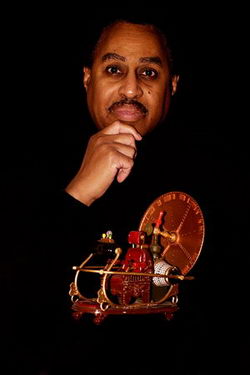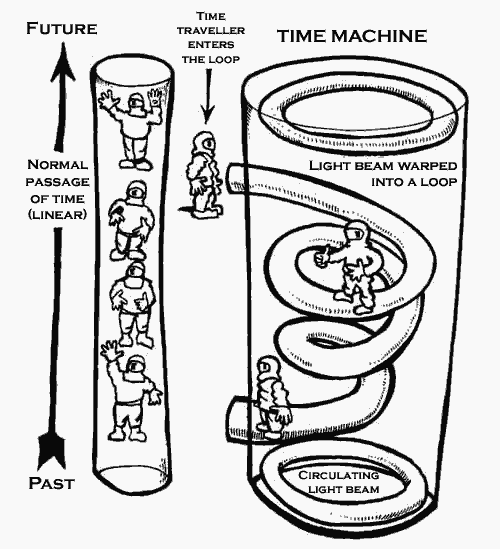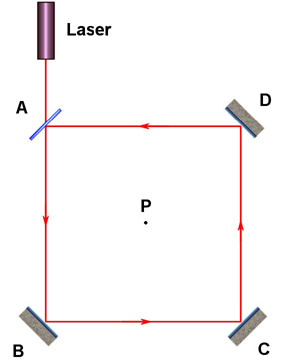 Ph.
D. Ronald L. Mallett, Professor at the University of Connecticut, has
used Einstein�s equations to design a time machine with circulating laser
beams. While his team is still looking for funding, he hopes to build
and test the device in the next 10 years.
Ph.
D. Ronald L. Mallett, Professor at the University of Connecticut, has
used Einstein�s equations to design a time machine with circulating laser
beams. While his team is still looking for funding, he hopes to build
and test the device in the next 10 years.
Ronald Mallett was born in Roaring Spring, Pennsylvania, on March 3, 1945. When he was 10 years old, his father died, at age 33, of a massive heart attack. Inspired by a Classics Illustrated comic book version of H.G. Wells' The Time Machine, Mallett resolved to travel back in time to save his father by telling him not to smoke, which became his life's dream.
In 1973, Ronald Mallett received a Ph.D. from Penn State University. Also that year, he received the Graduate Assistant Award for Excellence in Teaching. In 1975, he was appointed a job at the University of Connecticut as an assistant professor, where he continues to work today. His research interests include general relativity, quantum gravity and time travel. In 1980, he was promoted to associate professor, and since 1987, he has been a professor. He has received two grants and many other distinctions. In 2007, his life story of pursuing a time machine was told on This American Life, episode #324.
According to Einstein's theory of gravitation, any object with mass will cause a warp in space-time, similar to a bowling ball on a mattress. Because space and time has been stretched, clocks operate slower close to Earth than in the vast areas between galaxies. Einstein showed also that time is affected by motion, and his theories have been demonstrated experimentally in 1975 by Professor Carrol Alleyby, comparing time on an atomic clock that has traveled around the earth on a jet. It went slightly slower than an atomic clock on earth and although it regained its normal pace when it landed, it never caught up with earth clocks � which means that we have a time traveler from the past among us already, even though it thinks it�s in the future.
 Einstein
showed that mass and energy are the same thing and Ronald Mallett believes
that anything containing energy could warp space-time, and as a result,
he has designed a time machine that uses light, rather than mass. His
theoretical time machine consists of a ring of two intense beams of light,
circling in opposite directions. By slowing down the light in an ultra-cold
bath of atoms and increasing the intensity of the beams, space-time inside
the ring would become warped. Eventually, space and time would become
so distorted by the circling light that time would become a dimension
similar to space - a dimension that you could move along! If you entered
the ring and walked in the correct direction, you could walk back through
time - maybe even passing yourself as you entered the ring!
Einstein
showed that mass and energy are the same thing and Ronald Mallett believes
that anything containing energy could warp space-time, and as a result,
he has designed a time machine that uses light, rather than mass. His
theoretical time machine consists of a ring of two intense beams of light,
circling in opposite directions. By slowing down the light in an ultra-cold
bath of atoms and increasing the intensity of the beams, space-time inside
the ring would become warped. Eventually, space and time would become
so distorted by the circling light that time would become a dimension
similar to space - a dimension that you could move along! If you entered
the ring and walked in the correct direction, you could walk back through
time - maybe even passing yourself as you entered the ring!
Ronald Mallett first argued that the ring laser would produce
a limited amount of frame-dragging which might be measured experimentally:
In Einstein's general theory of relativity, both matter and energy
can create a gravitational field. This means that the energy of a light
beam can produce a gravitational field. My current research considers
both the weak and strong gravitational fields produced by a single continuously
circulating unidirectional beam of light. In the weak gravitational field
of a unidirectional ring laser, it is predicted that a spinning neutral
particle, when placed in the ring, is dragged around by the resulting
gravitational field.
(R. L. Mallett, "Weak gravitational field of the electromagnetic radiation
in a ring laser", Phys. Lett. A 269, 214 (2000))
In a later paper, Ronald Mallett argued that at sufficient
energies, the circulating laser might produce not just frame-dragging
but also closed timelike curves, allowing time travel into the past:
For the strong gravitational field of a circulating cylinder of light,
I have found new exact solutions of the Einstein field equations for the
exterior and interior gravitational fields of the light cylinder. The
exterior gravitational field is shown to contain closed timelike lines.
The presence of closed timelike lines indicates the possibility of time
travel into the past. This creates the foundation for a time machine based
on a circulating cylinder of light.
(R. L. Mallett, "The gravitational field of a circulating light beam",
Foundations of Physics 33, 1307 (2003))
 To
determine if time loops exist, Ronald Mallett is designing a desktop-sized
device that will test his time-warping theory. By arranging mirrors, he
can make a circulating light beam which should warp surrounding space.
Because some subatomic particles have extremely short lifetimes, he hopes
that he will observe these particles to exist for a longer time than expected
when placed in the vicinity of the circulating light beam. A longer lifetime
means that the particles must have flowed through a time loop into the
future. Say you have a cup of coffee and a spoon, the coffee is empty
space, and the spoon is the circulating light beam. When you stir the
coffee with the spoon, the coffee � or the empty space � gets twisted.
Suppose you drop a sugar cube in the coffee. If empty space were twisting,
you�d be able to detect it by observing a subatomic particle moving around
in the space. And according to Einstein, whenever you do something to
space, you also affect time. Twisting space causes time to be twisted,
meaning you could theoretically walk through time as you walk through
space.
To
determine if time loops exist, Ronald Mallett is designing a desktop-sized
device that will test his time-warping theory. By arranging mirrors, he
can make a circulating light beam which should warp surrounding space.
Because some subatomic particles have extremely short lifetimes, he hopes
that he will observe these particles to exist for a longer time than expected
when placed in the vicinity of the circulating light beam. A longer lifetime
means that the particles must have flowed through a time loop into the
future. Say you have a cup of coffee and a spoon, the coffee is empty
space, and the spoon is the circulating light beam. When you stir the
coffee with the spoon, the coffee � or the empty space � gets twisted.
Suppose you drop a sugar cube in the coffee. If empty space were twisting,
you�d be able to detect it by observing a subatomic particle moving around
in the space. And according to Einstein, whenever you do something to
space, you also affect time. Twisting space causes time to be twisted,
meaning you could theoretically walk through time as you walk through
space.
However, putting Ronald Mallett's theory into practice presents plenty of problems. For example, the temperature of the ring would have to be close to absolute zero (-273�C), so humans would find it difficult to use. It would also be impossible to travel back to a time before the machine was switched on. This explains why people from the future haven't visited us - we are yet to build a time machine for them to exit from. Mallett hopes that travellers from the future may be able to overcome these difficulties and use the rings of light that we construct today as portals to our time.
Some people show concern over time traveling, although Ronald Mallett � an advocate of the Parallel Universes theory � assures us that time machines will not present any danger. �The Grandfather Paradox [where you go back in time and kill your grandfather] is not an issue,� said Mallett. �In a sense, time travel means that you�re traveling both in time and into other universes. If you go back into the past, you�ll go into another universe. As soon as you arrive at the past, you�re making a choice and there�ll be a split. Our universe will not be affected by what you do in your visit to the past.�
The 2003 BBC documentary The World's First Time Machine, directed by Ben Bowie and featuring Ronald Mallett, premiered in the USA on The Learning Channel on December 3, 2003. This documentary features some of Ronald Mallett's current time travel research.
Funding for Ronald Mallett's program, now known as The Space-time Twisting by Light (STL) project, is progressing. Full details on the project, his theories, a list of upcoming public lectures and links to popular articles on his work can be found at the professor's web page, and an illustration showing the concept on which he has designed the time machine can be seen here. He also wrote a book titled Time Traveler: A Scientist's Personal Mission to Make Time Travel a Reality, co-written with New York Times best-selling author Bruce Henderson, that was published on October 28th, 2006.
Sources and links:
Facts
about Ronald L.Mallett and objections to his time travel theory:
http://en.wikipedia.org/wiki/Ronald_Mallett
Contact
to professor Ronald L.Mallett and a link to his personal home page:
http://www.phys.uconn.edu/People/Faculty/mallett.html
A
page with the two above mentioned technical papers (in PDF-files) by Ronald
L. Mallett:
http://www.phys.uconn.edu/~mallett/main/time_travel.htm
An
article about Ronald Mallett and his time travel theory by Lisa Zyga (2006):
http://www.physorg.com/news63371210.html
A lot of articles about Ronald L Mallett, real life time travel and holographic
communication:
http://www.quantumleap-alsplace.com/mediapages/realtimetravel.htm
An
article about Ronald Mallett, his time travel theory and wormholes by
Elizabeth warnes (2002):
http://www.abc.net.au/science/slab/wormholes/default.htm
A
summary of the 2003
BBC documentary "The World's First Time Machine":
http://www.youtube.com/watch?v=EWnoMaSgYPY
Sandra Petojevic, Master of Arts, March 16, 2008
Back to Other Time Machine productions